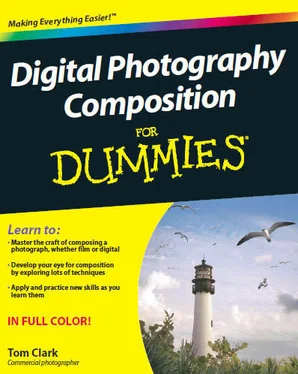Some shutter release cables have a time-lapse setting that enables you to set the time between shots, allowing the camera and cable release to do all the work from there. If you don't have a cable release with this option, you'll have to manually time and execute your shots.
When composing an image for a time lapse, keep in mind the changes you expect to occur. If you're shooting the sunset, for example, compose your image so the sun sets in a way that looks good compositionally (check out Chapter 5 for info on arranging elements in a frame). If you're shooting the sunrise, predict where the sun will breach the horizon and compose your image based on that.
This technique can be fun to experiment with, and it's a good way to get a feel for creating video (which is sort of like a cousin of photography). Your time-lapse images can be put together using any basic video editing software. For more information of using digital video software, take a look at Digital Video For Dummies, 4th Edition, by Keith Underdahl (Wiley).
Photographers tend to have emotional connections to their own work, and these connections disable them from having a clear vision as to whether the work is technically adequate and successfully conveys a message to viewers. So, one of the most important aspects of developing your compositional skills as a photographer is having your work critiqued by people who don't know you and who can be critical and honest. Having these folks see your images and give feedback on what they got from the experience helps you figure out what works effectively and what requires a greater effort.
You can find Web sites that allow you to upload images of your own to be critiqued. Examples include the following sites: jpgmag. com, photoarts forum. com, and www. naturephotographers. net. At sites like these, you can also critique the works of others. Doing so gives you insight as to what common mistakes are made and what to avoid when composing photographs. During this process, compare your work to that of other photographers to see how yours stands out. Are you happy with the results of the comparisons? If not, figure out what makes you unhappy about the photo and how you can make changes in the future. Photographic composition is an ever-evolving skill, so don't ever be embarrassed to admit that you can do better next time.
Chapter 21. Viewing Ten Compositions of One Scene
In This Chapter
Applying different compositions to the same scene
Tweaking your message with composition
Being a photographer is about much more than simply pointing your camera and taking a picture. You also have to make decisions regarding your photo's composition. These decisions determine how viewers see an image and how it compares to other images of a similar subject. Every composition you choose provides a unique message. To prove my point, in this chapter, I provide ten images and accompanying descriptions to show how a single subject in a scene can be photographed to reveal ten different messages.
Choosing a High Angle to Short the Scene
The height of your camera affects how a viewer sees a subject in relation to its environment. A high angle, like the one used in Figure 21-1, helps reveal information in your scene that's related to the subject. (Refer to Chapter 8 for more on choosing an angle to tell your story.)
In the figure, notice how you can see the surface of the path and the dunes and see just how far the walkway stretches before reaching the beach. I minimized the sky in this composition to maximize how much of the ground's details are shown. The subject is placed near the bottom right third in front of a shadowed area so she stands out visually and helps the leading lines created by the wood handrails lead your eyes to the beach in the background. You can clearly tell what the subject is while at the same time being invited to check out the scenery.
50mm, l/200sBC.,f/1.8,50
Figure 21-1:A high angle emphasizes the environment.
Selecting a Low Angle to Emphasize the Subject
As opposed to using a high angle (which you can read about in the preceding section), using a low angle in a photographic composition helps you to put more emphasis on your subject and less on the surrounding elements. Look at Figure 21-2 to see what I mean. In this photo, I draw more attention to the model and less to the environment surrounding her. You can still get an idea of where the woman is, but this composition says more about her than her environment.
50mm, 1/200 sec.,f/5.6,400
Figure 21-2:A low angle emphasizes the subject.
Low angles are great for emphasizing height in a subject. The lower you get, the more sky you see, and the more your subjects begin to tower over your camera. You can read more on finding the right camera angle in Chapter 8.
Highlighting the Subject and the Scene with a Wide-Angle Lens
A wide-angle lens can be used to maximize how much detail you show in a scene. At the same time, when shooting with a wide angle of view, changing the distance between you and your subject can have a drastic effect on how viewers see the subject. In other words, with a wide-angle lens you can get the best of both worlds: a glimpse of the surrounding elements and information about the subject.
In Figure 21-3, for example, I revealed details in the model's face and wardrobe by standing close to her. However, you also get a good view of the scene around her. (See the following section for a shot with the same lens but different results.) You can read more about choosing the appropriate lens in Chapter 3.
28mm, WOOsec.,V5.S,400
Figure 21-3:Get close to your subject with a wide-angle lens in orderto maximize detail in the environment and the subject at the same time.
Shootinq More Scenery with a Wide-Anqle Lens
Figure 21-3 (see the preceding section) and Figure 21-4 both were photographed with the same wide-angle lens, but you can see that the subject is represented much differently in each image. Even though a wide-angle lens allows you to get similar amounts of detail in both your subject and its environment (check out the preceding section), you also can use this type of lens to get an expansive view of the scene while minimizing the presence of the subject — as I did in Figure 21-4.
28mm, 1/200 sec, f/4,400
Figure 21-4:To make your subject become part of the environment, place her farther into the scene when using a wide-angle lens.
Notice how Figure 21-3 and Figure 21-4 show about the same amount of the environment in the scene. You can see the palm trees, the path, and the sky in each. The main difference in Figure 21-4 is the size of the subject in the frame. By having her stand farther down the pathway, I made her seem more a part of the scene. Because she's more difficult to spot in this composition, I made sure to place her on the right third and have the leading lines of the dunes and handrail guide your eyes to her. She is, after all, still the subject.
Shootinq a Subject with a Lonq Lens
If, for your composition, you feel that it's unnecessary to maximize the details in a scene, you can zero in on your subject and minimize the environment by using a long lens. These lenses have a narrower angle of view, so they naturally reveal a smaller portion of the environment. They also tend to create a shallower depth of field. The combination of these two factors can cause a subject to stand out from her background, making it easier for viewers to concentrate on her.
Читать дальше
Конец ознакомительного отрывка
Купить книгу












